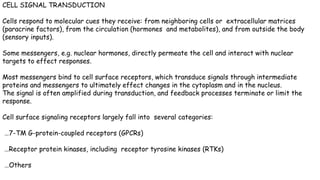
Cell signal lecture
- 1. CELL SIGNAL TRANSDUCTION Cells respond to molecular cues they receive: from neighboring cells or extracellular matrices (paracrine factors), from the circulation (hormones and metabolites), and from outside the body (sensory inputs). Some messengers, e.g. nuclear hormones, directly permeate the cell and interact with nuclear targets to effect responses. Most messengers bind to cell surface receptors, which transduce signals through intermediate proteins and messengers to ultimately effect changes in the cytoplasm and in the nucleus. The signal is often amplified during transduction, and feedback processes terminate or limit the response. Cell surface signaling receptors largely fall into several categories: …7-TM G-protein-coupled receptors (GPCRs) …Receptor protein kinases, including receptor tyrosine kinases (RTKs) …Others
- 2. Insulin Receptor is Receptor Tyrosine Kinase Activated by Insulin-Induced Receptor Autophosphorylatio Autophosphorylation is really receptor subunit transphosphorylation. Autophosphorylation stimulates the receptor’s kinase activity AND creates receptor recruitment sites for signaling targetproteins.
- 4. Second Messengers Are Synthesized or Mobilized During Signaling
- 5. Cell Communication Why do cells need to communicate? To coordinate the processes of life. Multicellular organisms have billions of cells that must communicate to develop and survive. Unicellular organisms must also communicate in order to locate nutrients and in some cases identify mating partners. Example: Saccharomyces cerevisiae—the fungus that humans have used for centuries to make bread, wine, and beer. Use of chemical signal to find potential mates. Alpha and a cells: The cells that are communicating might be close together or far apart
- 6. Signal Reception and Initiation of Transduction 1) Binding of messenger-- Chemical messenger binds to receptor protein, and the protein changes shape (conformational change.) The messenger fits into the receptor like a key in a lock— it behaves as aligand. 2) Receptors-- Most receptors are plasma membrane proteins. We can divide the types of receptors in to a few major categories based on their structure and how they work: G-protein linked receptors, tyrosine-kinase receptors, and ion-channel receptors. a. G-protein-linked receptors: b. Tyrosine-kinase receptors: c. Ion-Channel receptors:
- 7. Signal Transduction Pathways Transduction has many steps and can result in amplification of signal. (Small signal produces big response…) 1) Transduction pathways relay information. The ligand binds to a receptor on the plasma membrane, causing a conformational change in the receptor, which triggers a cascade of events. The activated receptor protein activates a series of other proteins that relay the information. 2) Protein phosphorylation is major mechanism of signal transduction in cells. Protein kinase-- Protein phosphotase-- 3) Second messengers play a role in signal transduction pathways. Small, water-soluble , and nonprotein, they can spread throughout cell by diffusion. Two most common cyclic AMP and Ca++. a. Cyclic AMP
- 8. How can pathways interact to form single reponses?